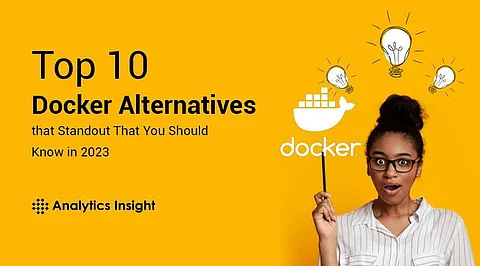
- Insights
- Cryptocurrencies
- Stocks
- White Papers
- Industry
- Geography


Docker has several standalone alternatives, some of which offer virtualization technologies and cross-platform support. Docker alternatives that stand out are also Open Container Initiative (OCI) tools that work with Docker, replace some Docker components, or work with other Docker alternatives to form robust Docker competitors.
Thanks to its contemporary tools, compatibility, sizable community, and simplicity of use, Docker is still relevant for the majority of container projects, apps, and developers today. The licensing for Docker Desktop has recently changed, among other modifications made by Docker Inc. Consider these Docker alternatives that stand out in 2023 if you're worried about the future of Docker and the exponential growth of Kubernetes because there are probably yet more changes to come. In this article, we'll discuss the top Docker alternatives that stand out in 2023.
On Linux-based systems, virtual machines and system containers are managed by the Linux Daemon (LXD). It is quick, safe, and extremely scalable, and it is image-based. Even more sophisticated workloads may be managed by setting them up in a cluster management environment using virtual machines (VMs), containers, or both, on a group of servers. LXD may be thought of as a REST API that links to the libxlc library for Linux Containers (LXC).
For many years, Docker's primary container runtime has been Containerd, a CNCF-graduated project. RunC is presently used by Docker. For its host system, Containerd manages every facet of the container lifecycle.
A portable, lightweight, and secure tool called ZeroVM is used to build isolated environments where a single process may operate at a time. The Chromium Native Client (NaCl) project provides the basis for this strategy. Other virtualization and container technologies, in comparison, offer a completely virtualized operating system and running environment for running several processes.
The lib pod library is used by the Linux-native container engine Podman to provide tools for managing the lifetime of containers. The application is excellent at executing the commands and operations, such as pulling and tagging, that update and modify OCI pictures. Additionally, it aids in building, running, and maintaining the containers you build using those images.
You may replicate several, conditioned virtual environments across several operating systems and virtual machines with HashiCorp's Vagrant. It makes it easier to create a virtual environment that you can duplicate on various networks, VMs, and OSs. Interoperability is facilitated by this. For app development, staging, and deployment, you may also establish complementary virtual environments.
You may use Docker Command-Line Tools to store and manage container images using a private Docker registry that is accessible through Microsoft Azure Container Registry. It supports Twist Lock compatibility, runtime protection, and screening for container vulnerabilities in addition to strong security features. Running container projects on Microsoft Azure makes sense because it is the second most popular cloud computing platform behind Amazon Web Services (AWS).
RunC is a Command-Line Tool for spawning and operating containers on Linux systems that are hosted on GitHub. Based on OCI standards, it performs this. RunC used to be a low-level utility, hence it wasn't recommended for end users to use it directly. Now that a standalone version of runC is available, you may use it independently or with Docker.
BuildKit is an image-building tool included in Docker Build that was developed by the Moby Project (Docker version 18.09 and later). Additionally, Moby offers it as a standalone tool. BuildKit runs as a daemon, just like Docker. Conversely, BuildKit uses parallel build processing to increase speed for quicker builds whereas Docker creates each image layer individually.
Buildah could be your best option if you want to create OCI container images without setting up a standalone container runtime or daemon. Buildah's main goal is to produce OCI photos. Its instructions repeat those found in a Dockerfile. As a result, you can construct images both with and without Dockerfiles without having to have root access. Both Docker and Kubernetes will continue to support the images.
Application container engine rkt, formerly known as CoreOS Rocket, is appropriate for use in cloud-native production settings. Rkt is a leading Docker substitute thanks to its pod-native framework and pluggable execution environment, which effortlessly connect with other systems. You may use Rkt to apply different settings both at the pod level and per-application level, including isolation parameters.
